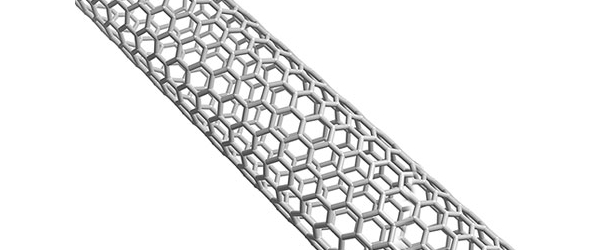Home > Press > Researchers discover recipe for controlling carbon nanotubes
 |
| Carbon nanotubes are cylindrical carbon molecules whose novel properties make them useful for applications in chemical engineering, nanotechnology, electronics and other areas. |
Abstract:
Carbon nanotubes hold promise for delivering medicine directly to a tumor; acting as sensors so keen they detect the arrival or departure of a single electron; replacing costly platinum in fuel cells; or as energy-saving transistors and wires, but building them with the right structure has been a challenge.
Researchers discover recipe for controlling carbon nanotubes
Cleveland, OH | Posted on October 14th, 2009Now, two Case Western Reserve University researchers have found that mixing different metals in a catalyst can help determine the tubes' structure and function, or chirality.
"We have established a link between the structure of a catalyst and the chirality of carbon nanotubes," said R. Mohan Sankaran, an assistant professor of chemical engineering at the Case School of Engineering. "Change the catalyst structure by varying its composition, and you can begin to control the chirality of the nanotubes and their electrical and optical properties."
Nanotubes are normally grown in bulk mixtures. When using a nickel catalyst, typically one-third of those grown are metallic and could be used like metal wires to conduct electricity. About two-thirds are semiconducting nanotubes, which could be used as transistors, said Wei-Hung Chiang, who received his doctorate in chemical engineering in May. But separating them according to properties is "costly and can damage the nanotubes," Chiang said.
Better to make what you want.
Chiang and Sankaran found that a mixed iron and nickel catalyst could change the outcome. Of the compositions tested, a catalyst of 27 percent nickel and 73 percent iron produced the most dramatic result: the majority of the nanotubes were semiconducting. The researchers are now working on assessing the purity and integrating the nanotubes into thin film transistors.
Chiang and Sankaran say their findings open the door to experimenting with other elements as catalysts and different combinations, which may produce near-pure nanotubes with desired properties. Their findings appear in a letter published Sept. 20 in the online edition of Nature Materials.
####
For more information, please click here
Copyright © Case Western Reserve University
If you have a comment, please Contact us.Issuers of news releases, not 7th Wave, Inc. or Nanotechnology Now, are solely responsible for the accuracy of the content.
| Related News Press |
News and information
![]() Researchers develop molecular qubits that communicate at telecom frequencies October 3rd, 2025
Researchers develop molecular qubits that communicate at telecom frequencies October 3rd, 2025
![]() Next-generation quantum communication October 3rd, 2025
Next-generation quantum communication October 3rd, 2025
![]() "Nanoreactor" cage uses visible light for catalytic and ultra-selective cross-cycloadditions October 3rd, 2025
"Nanoreactor" cage uses visible light for catalytic and ultra-selective cross-cycloadditions October 3rd, 2025
![]() Researchers tackle the memory bottleneck stalling quantum computing October 3rd, 2025
Researchers tackle the memory bottleneck stalling quantum computing October 3rd, 2025
Chemistry
![]() "Nanoreactor" cage uses visible light for catalytic and ultra-selective cross-cycloadditions October 3rd, 2025
"Nanoreactor" cage uses visible light for catalytic and ultra-selective cross-cycloadditions October 3rd, 2025
![]() Cambridge chemists discover simple way to build bigger molecules – one carbon at a time June 6th, 2025
Cambridge chemists discover simple way to build bigger molecules – one carbon at a time June 6th, 2025
Nanotubes/Buckyballs/Fullerenes/Nanorods/Nanostrings
![]() Enhancing power factor of p- and n-type single-walled carbon nanotubes April 25th, 2025
Enhancing power factor of p- and n-type single-walled carbon nanotubes April 25th, 2025
![]() Chainmail-like material could be the future of armor: First 2D mechanically interlocked polymer exhibits exceptional flexibility and strength January 17th, 2025
Chainmail-like material could be the future of armor: First 2D mechanically interlocked polymer exhibits exceptional flexibility and strength January 17th, 2025
![]() Innovative biomimetic superhydrophobic coating combines repair and buffering properties for superior anti-erosion December 13th, 2024
Innovative biomimetic superhydrophobic coating combines repair and buffering properties for superior anti-erosion December 13th, 2024
Discoveries
![]() Researchers develop molecular qubits that communicate at telecom frequencies October 3rd, 2025
Researchers develop molecular qubits that communicate at telecom frequencies October 3rd, 2025
![]() Next-generation quantum communication October 3rd, 2025
Next-generation quantum communication October 3rd, 2025
![]() "Nanoreactor" cage uses visible light for catalytic and ultra-selective cross-cycloadditions October 3rd, 2025
"Nanoreactor" cage uses visible light for catalytic and ultra-selective cross-cycloadditions October 3rd, 2025
Announcements
![]() Rice membrane extracts lithium from brines with greater speed, less waste October 3rd, 2025
Rice membrane extracts lithium from brines with greater speed, less waste October 3rd, 2025
![]() Researchers develop molecular qubits that communicate at telecom frequencies October 3rd, 2025
Researchers develop molecular qubits that communicate at telecom frequencies October 3rd, 2025
![]() Next-generation quantum communication October 3rd, 2025
Next-generation quantum communication October 3rd, 2025
![]() "Nanoreactor" cage uses visible light for catalytic and ultra-selective cross-cycloadditions October 3rd, 2025
"Nanoreactor" cage uses visible light for catalytic and ultra-selective cross-cycloadditions October 3rd, 2025
|
|
||
|
|
||
| The latest news from around the world, FREE | ||
|
|
||
|
|
||
| Premium Products | ||
|
|
||
|
Only the news you want to read!
Learn More |
||
|
|
||
|
Full-service, expert consulting
Learn More |
||
|
|
||








